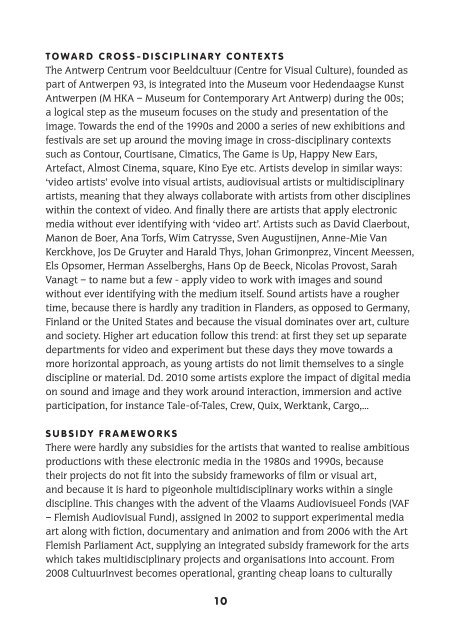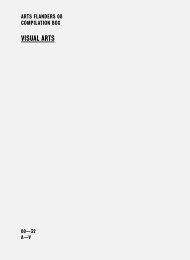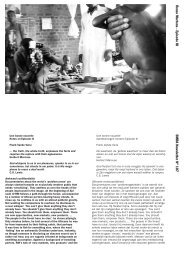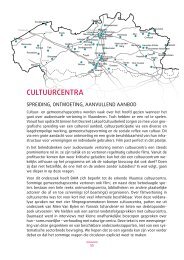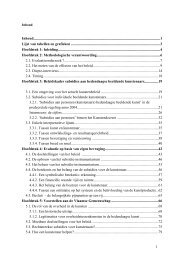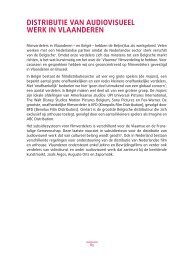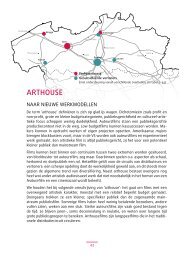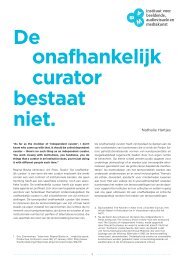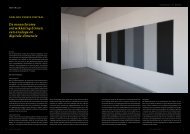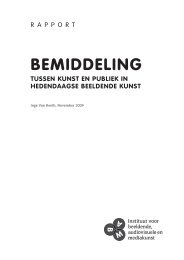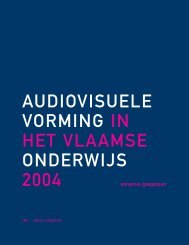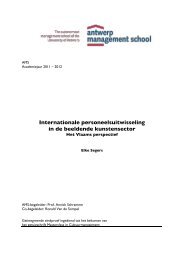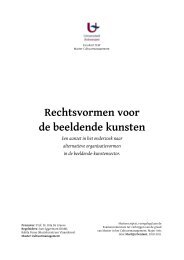MEDIA DIGITAL ART AND CULTURE IN FLANDERS BELGIUM - BAM
MEDIA DIGITAL ART AND CULTURE IN FLANDERS BELGIUM - BAM
MEDIA DIGITAL ART AND CULTURE IN FLANDERS BELGIUM - BAM
You also want an ePaper? Increase the reach of your titles
YUMPU automatically turns print PDFs into web optimized ePapers that Google loves.
T O W A R D C R O S S - D I S C I P L I N A R Y C O N T E X T S<br />
The Antwerp Centrum voor Beeldcultuur (Centre for Visual Culture), founded as<br />
part of Antwerpen 93, is integrated into the Museum voor Hedendaagse Kunst<br />
Antwerpen (M HKA – Museum for Contemporary Art Antwerp) during the 00s;<br />
a logical step as the museum focuses on the study and presentation of the<br />
image. Towards the end of the 1990s and 2000 a series of new exhibitions and<br />
festivals are set up around the moving image in cross-disciplinary contexts<br />
such as Contour, Courtisane, Cimatics, The Game is Up, Happy New Ears,<br />
Artefact, Almost Cinema, square, Kino Eye etc. Artists develop in similar ways:<br />
‘video artists’ evolve into visual artists, audiovisual artists or multidisciplinary<br />
artists, meaning that they always collaborate with artists from other disciplines<br />
within the context of video. And finally there are artists that apply electronic<br />
media without ever identifying with ‘video art’. Artists such as David Claerbout,<br />
Manon de Boer, Ana Torfs, Wim Catrysse, Sven Augustijnen, Anne-Mie Van<br />
Kerckhove, Jos De Gruyter and Harald Thys, Johan Grimonprez, Vincent Meessen,<br />
Els Opsomer, Herman Asselberghs, Hans Op de Beeck, Nicolas Provost, Sarah<br />
Vanagt – to name but a few - apply video to work with images and sound<br />
without ever identifying with the medium itself. Sound artists have a rougher<br />
time, because there is hardly any tradition in Flanders, as opposed to Germany,<br />
Finland or the United States and because the visual dominates over art, culture<br />
and society. Higher art education follow this trend: at first they set up separate<br />
departments for video and experiment but these days they move towards a<br />
more horizontal approach, as young artists do not limit themselves to a single<br />
discipline or material. Dd. 2010 some artists explore the impact of digital media<br />
on sound and image and they work around interaction, immersion and active<br />
participation, for instance Tale-of-Tales, Crew, Quix, Werktank, Cargo,...<br />
S U B S I D Y F R A M E W O R K S<br />
There were hardly any subsidies for the artists that wanted to realise ambitious<br />
productions with these electronic media in the 1980s and 1990s, because<br />
their projects do not fit into the subsidy frameworks of film or visual art,<br />
and because it is hard to pigeonhole multidisciplinary works within a single<br />
discipline. This changes with the advent of the Vlaams Audiovisueel Fonds (VAF<br />
– Flemish Audiovisual Fund), assigned in 2002 to support experimental media<br />
art along with fiction, documentary and animation and from 2006 with the Art<br />
Flemish Parliament Act, supplying an integrated subsidy framework for the arts<br />
which takes multidisciplinary projects and organisations into account. From<br />
2008 CultuurInvest becomes operational, granting cheap loans to culturally<br />
1 0


